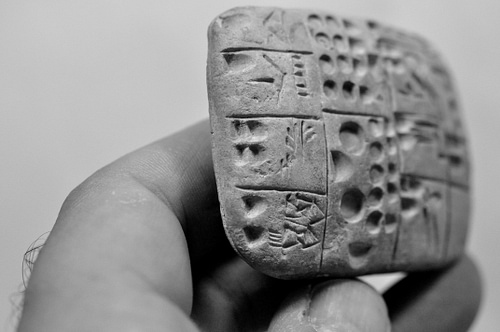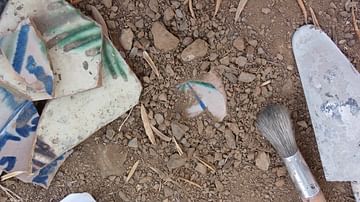He who saw everything in the broad-boned earth, and knew what was to be known,
Who had experienced what there was, and had become familiar with all things.The Epic of Gilgamesh.
The tornado has started
After the US-led invasion of Iraq in March 2003 CE and the catastrophic collapse of the Republic of Iraq, the tragedy of the looting of the Iraq Museum and several other museums in Iraq, as well as the wide-spread illegal excavations in Mesopotamia (Iraq) prompted the government of Kurdistan and its Ministry of Councils to issue a decree.
Accordingly, thanks to the government of Kurdistan and the Patriotic Union of Kurdistan and their unlimited sponsorship, the Sulaymaniyah Museum, from 2003 CE to the present, has built, protected, and stored a very large cache of relics, belonging to several Mesopotamian periods, cultures, and histories. Many of the objects, bought by the Sulaymaniyah Museum, belonged to the Iraq Museum in Baghdad (the letters “IM” followed by numbers were written on the surface of the object); the Sulaymaniyah Museum returned and delivered these artefacts to that Museum in Baghdad. It is noteworthy to mention that the Sulaymaniyah Museum is not sponsored or funded by the central federal Government in Baghdad!

Many people would consider this bargain unacceptable, as it would/will encourage more looters to sell their merchandise legally and more easily. Others argue that in that way, Iraqi Kurdistan, has been largely successful in intercepting the smuggling of Mesopotamian relics, and it is a very bold step to announce this publicly. I agree with the last opinion. For example, this is how the world enjoyed the newly unearthed tablet V of the Epic of Gilgamesh! I have heard and read many news stories that many objects from the Iraq Museum have been returned, but how? Many relics were in the United States, European countries, and neighbour countries. No one says how, or at the best, the majority will say no further information! It is understandable that some degree of lack of transparency should attend the scene.
Aftermath
I will now show you here some examples of these Mesopotamian clay tablets, currently housed in the Sulaymaniyah Museum. None of these tablets is on display and these photos are exclusive and never-before-seen. The hand which appears in each photo is mine; I held the tablets and shot them with my Nikon D90 camera in September 2014 CE. I have chosen 16 images out of approximately 10,000 ones I have.
Let us start with this tablet:
![Illegally Excavated Mesopotamian Clay Tablet [7]](https://www.worldhistory.org/img/r/p/500x600/7087.jpg?v=1599474605)
“Hi hi…it's ty ty!” While I was shooting this tablet from several angles, I found this. This is an Arabic word (وركاء) written on the tablet using a blue marker. It reads Warka (Uruk). The Museum's staff had no idea about this and did not notice it either! It was written by the plunderers; the tablet might well have been unearthed at the city of Uruk! Bang bang! Illegally excavated tablet.

![Illegally Excavated Mesopotamian Clay Tablet [3]](https://www.worldhistory.org/img/r/p/500x600/7101.jpg?v=1599475503)
![Illegally Excavated Mesopotamian Clay Tablet [4]](https://www.worldhistory.org/img/r/p/500x600/7099.jpg?v=1599475502)
![Illegally Excavated Mesopotamian Clay Tablet [9]](https://www.worldhistory.org/img/r/p/500x600/7102.jpg?v=1599475503)
Now, let's see some other examples of how those plunderers managed to do surgical operations on their merchandise to fool future potential buyers:
![Illegally Excavated Mesopotamian Clay Tablet [13]](https://www.worldhistory.org/img/r/p/500x600/7090.jpg?v=1618722902)
![Illegally Excavated Mesopotamian Clay Tablet [8]](https://www.worldhistory.org/img/r/p/500x600/7091.jpg?v=1618722903)
This tablet was broken into many pieces. The excavators tried to join its fragments. Note the modern cement which was used to fill in some lost spaces and to join the pieces all together. The right lower piece was remodelled and re-shaped using modern cement and in situ debris. Still, some pieces were missing and could not be replaced. Such a process of “repair" has resulted, not only, in a distorted shape, but also ended-up with the loss of many cuneiform signs; a disaster to scholars! Illegally excavated tablet.
![Illegally Excavated Mesopotamian Clay Tablet [5]](https://www.worldhistory.org/img/r/p/500x600/7093.jpg?v=1599475502)
![Illegally Excavated Mesopotamian Clay Tablet [6]](https://www.worldhistory.org/img/r/p/500x600/7100.jpg?v=1599475503)
A multi-fragment clay tablet joined together by modern cement and in situ debris. Some of the filling in fragments are unrelated; the tablet had to appear a complete item. Illegally excavated tablet.
![Illegally Excavated Mesopotamian Clay Tablet [10]](https://www.worldhistory.org/img/r/p/500x600/7092.jpg?v=1618722903)

![Illegally Excavated Mesopotamian Clay Tablet [2]](https://www.worldhistory.org/img/r/p/500x600/7098.jpg?v=1599475502)
![Illegally Excavated Mesopotamian Clay Tablet [11]](https://www.worldhistory.org/img/r/p/500x600/7094.jpg?v=1599475502)

![Illegally Excavated Mesopotamian Clay Tablet [12]](https://www.worldhistory.org/img/r/p/500x600/7095.jpg?v=1599475502)
These examples represent a drop in the ocean. From where do these tablets come? They have not popped-up from nowhere. Why it is very easy for plunderers to excavate and find such priceless relics? It seems that everybody knows that this or that hill or place is an ancient one and it holds ancient objects. What have our governments done so far through legal and scientific excavations and expeditions? Why is it difficult and time-consuming to scientifically unearth something, while illiterate gangsters do it in a very short time using primitive tools? Yes, I'm sure our readership knows the answers.
The aforementioned tablets came from Southern Mesopotamia, everybody knows that, and from already “diagnosed and labelled” crystal-clear ancient mounds, but the question is who is behind this organized illegal excavation which was done when the sun was at the heart of the sky?
A faint light at the end of the black tunnel
Let us take the newly discovered tablet V of the Epic of Gilgamesh, which was bought in late 2012 CE by the Sulaymaniyah Museum; this priceless tablet actually only cost $800 and was on its way to a neighbouring country. Researchers have added many new pieces of information to the Epic after transliterating the cuneiform text of this tablet. The tablet is on display in the Sulaymaniyah Museum of Iraqi Kurdistan.

Finally, I had the honour of seeing all of those illegally unearthed tablets, touching them, holding them, and above all, exclusively photographing them for research purposes.
A special gratitude goes to Mr. Hashim Hama Abdullah, director of the Sulaymaniyah Museum, and Mr. Kamal Rashid, director general of the Directorate of Antiquities in Sulaymaniyah for their extreme help and unlimited cooperation.
This article was written in memory of the late Iraqi Archaeologist Taha Baqir (1912-1984).
It is not what you find, it is what you find out.
David Hurst Thomas.







